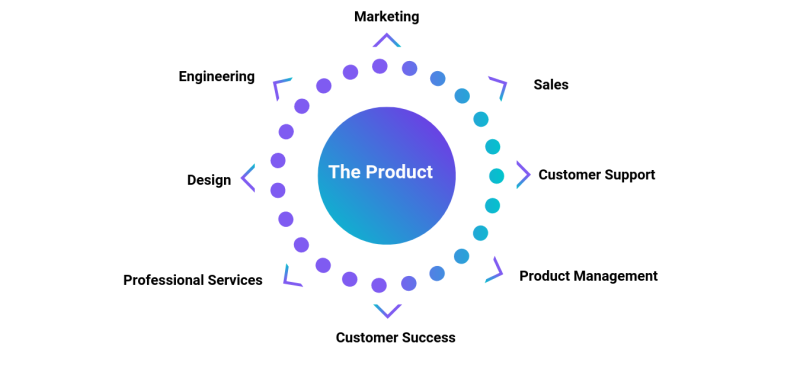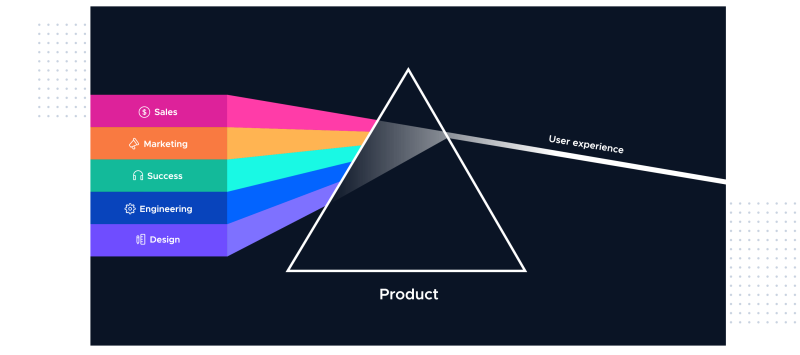Introduction To Product-led Growth and the Role Product Managers Play

“Product-led growth is about using your product and your product data to convert prospects, retain users, and expand customers. In today's highly competitive SaaS market,product-led growth needs to be an essential component of your technology business." (Eric Boduch, Chief Evangelist, Pendo)
As a SaaS product manager, this quote must be music to your ears. Who would not want their product to be at the center of the business?

Introduction to product-led growth
Traditionally, SaaS companies use a sales team to acquire customers.
First, prospects book a demo. Then, they go through a lengthy process to discover if the product is a good fit, they get a test installation (sometimes), and the price is negotiated.
This typically takes weeks, if not months and is expensive for the SaaS company.
Product-led growth completely up-ends this process.
Instead of being sold through a sales team, the product sells itself.

Your prospective customers self-serve by signing up and trialing your product, discover its benefits and the experience and make up their mind in their own time.
At very little or no cost to you.
In a product-led growth process, you let your product shine rather than your sales team.
The key ingredients for success are
Self-serve free trial or freemium model
Streamlined onboarding process that showcases the product
Sales funnel built into the product
Why change to a product-led growth model?
Selling software through a sales team is an expensive business. The customer acquisition cost (CAC) per customer is high.

This in itself is a reason to strive to reduce that cost.
But there is another dangerous effect. Due to the high CAC, the sales team will always chase the biggest contracts they can get. This means that:
You may end up dependent on a few very big enterprise customers. This is risky for your business. Also, these big customers will likely drive your roadmap to a large extent. The needs of a much bigger group of smaller potential customers will not be prioritized.
You also cannot access the very big group of smaller potential customers as they are just not “worth” the attention of your sales team in expected returns.
Letting the product sell itself is cheap in comparison.
So the cost of your sales team and hence the CAC can be drastically reduced.
This also means that you can achieve global reach without a sales team in every region.
Last but not least, the times of cryptic workplace products that require reading a manual, complex installation and configuration and training for all employees are over.
Your B2B customers are also B2C customers of many other products.
More and more, they expect a smooth and intuitive experience from B2B products as well. If they can learn about the value of your product through their own experience, your customers can make up their minds in their own time.
In the world of B2C, free trials or freemium models are very common.
If your prospects’ very first experience with your product is a prompt to book a demo, you may have already lost them there and then.
Experiencing your product live rather than a sales slide deck instills trust that you can deliver what you promise.

Show, not tell!
Consequently, if you are a traditional SaaS company using a sales-led process catering mainly for Enterprise customers, you may well find new competitors entering that start eating into your market from the bottom end of customer size and inch closer to your customers as they grow.
Convinced yet? Find out what you can do to switch to a product-led model.
How to implement a product-led growth model
In a product-led company, the product is at the center of everything.
All teams contribute to the product from their perspective.

Marketing thinks about how to highlight the value of the product to prospects directly in the product itself.
Customer success thinks about how to empower customers directly in the product.
Sales think about how and when to prompt for sale in the product during a trial period. (In the full implementation, you may not even need a sales team anymore)
Product - well, product managers orchestrate all the other teams to make sure that the product ends up as a compelling and coherent experience as a whole.
The key to unlocking product-led growth is a super-optimized signup and onboarding process. This includes
Ruthlessly scrutinizing the user journey and removing any steps that are not necessary in a first experience (for example, do you really need email verification directly on signup?).
Allowing as full an experience as possible in a free trial. This may mean including some dummy data set up in a new account that allows prospects to play without setting up their own data first.
Progressively educating trial customers through interactive tutorials and tips on what to do next as they learn how to use your product. Reveal new information in bite-sized chunks when they are ready for it on repeat visits.
Guiding trial customers through the onboarding to highlight your product’s core value to them using tools like appcues.

Allowing customers to see your pricing structure as they experience the product.
Prompt them to buy only when they are ready to do so, i.e., when they have experienced the full value of your product.
You may not be able to provide access to the full product, for example, because it requires integration into a customer’s environment before it can be used. In that case, you can also create a marketing version that showcases the product but simulates certain parts of it. Think of it as a sophisticated prototype.
Beyond onboarding, there are a few other things you can do to boost your sales:
Embed yourself in the customers’ real-life workflows early and easily. Slack is a good example of that. Once you have some chats going, prospects may not want to give this up anymore.
Include some “viral” aspects into your product. Let your customers find new customers for you. A good example of this is Surveymonkey. After completing a survey, users land on a page prompting them to create their own surveys by signing up.
After converting a prospect to a customer, you can still teach them more about the advanced uses of your product in guided tutorials and tips. Getting them to use your product more keeps them happy and more likely to renew next year.
There are also opportunities for upselling through communication directly in the product here once they have gained some experience and have come to value your product.
The success of your product-led onboarding depends heavily on the extensive use of data about your prospective customers. Analysis of data will allow you to do several things:

Identify points of friction by seeing where customers drop off in your process and eliminating these points.
Micro-target customer segments with the right messaging based on what they have already seen and done.
Run A/B tests what messaging and flows convert prospects best. In traditional B2B products, A/B tests are often tricky due to low user numbers. But if you are doing product-led growth right, you will have big numbers of users at the top of your sales funnel to analyze.
What does product-led growth mean for product managers?
In a traditional SaaS company, product management is often tactically driven by requests from (large) sales prospects. Product managers sometimes have little autonomy as the sales team mostly controls the roadmap.
In a product-led world, the product sits at the top of the funnel to acquire customers rather than at the end. All teams contribute to the product from their perspective.
The product manager has a central role in collaborate, coordinate and communicate with all teams to create a coherent, compelling product with a great experience.
This is very similar to how product management in B2C companies has been operating for years.
Traditional SaaS products built as a reaction to sales requests often end up with many features that only very few customers use.
This may lead to clutter and a confusing experience for customers who don’t know what these features are for (or a mass of cryptic configuration options).
In a product-led world, the focus is on letting the core functionality shine, so clutter must be eliminated. This leads to a much better experience for all customers.
Conclusion
Product-led growth as a concept in SaaS companies is likely to become the dominant model as it provides a competitive advantage over traditional sales-driven models:
Cost savings due to low customer acquisition cost
Cost savings due to reduced headcount requirement to sell worldwide
Ability to target a large market rather than only high-value enterprise customers
Shortening your sales process and improving conversion to paid customers through free trials
If you are still operating under a traditional sales-driven model, it is time to start thinking about how to improve the onboarding process in your product now and let your product speak for itself. The transition to a product-led model is not trivial and affects the whole company. But you want your product to be ready for it.

Kerstin Exner

Read also



Create effective product strategy

Experience the new way of doing product management




